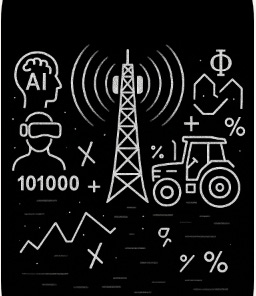The Invisible Infrastructure Revolution: How Cellular Technology Became the Foundation of Digital Realities
"You're tiptoeing big man, you need to strut" - Tony Stark
While everyone debates AI ethics and metaverse possibilities, John Deere quietly revolutionized manufacturing by deploying private 5G networks in just six weeks. The real story isn't the predictive maintenance or digital twins they enabled. It's the cellular infrastructure that made it all possible.
Cellular technology suffers from a peculiar curse: it works so reliably that we've forgotten how revolutionary it actually is. Like electricity or running water, cellular networks have become invisible utilities that we notice only when they fail.
This invisibility masks one of the most profound infrastructure transformations happening right now.
The Foundation Everyone Overlooks
Consider the cognitive architecture we explored in understanding mental bandwidth allocation. Just as we discovered that 47% of our mental processing gets consumed by background rumination, our perception of cellular technology gets overwhelmed by its apparent simplicity.
We see phones making calls and miss the sophisticated data orchestration happening beneath the surface.
Today's cellular networks aren't just carrying voice conversations and streaming videos. They're becoming the nervous system for what I call Digital Realities, where physical and digital experiences converge in shared environments.
Every spatial computing application, every ambient AI system, every real-time collaborative interface depends on cellular infrastructure to function seamlessly across geographic boundaries.
The data demands are becoming exponential.
When every surface can become an interface, when AI systems need to process environmental context in real-time, when manufacturing equipment generates continuous streams of sensor data, traditional cellular capacity hits fundamental limits.
This is where the next wave of innovation becomes critical.
6G - The Polarization Multiplexer Breakthrough
The University of Adelaide recently achieved something that sounds impossibly technical but represents a massive leap forward.
Their team developed the first ultra-wideband integrated terahertz polarization multiplexer on a silicon base. Strip away the academic language, and here's what matters: this device can double data transmission capacity by sending multiple data streams simultaneously over the same frequency band.
Think of it like transforming a single-lane highway into a sophisticated multi-level interchange, where different types of traffic can flow simultaneously without interference.
The polarization multiplexer doesn't just add more lanes. It creates entirely new dimensions of data flow within existing spectrum allocations.
This innovation addresses a fundamental constraint that most people don't realize exists. Spectrum is finite, and as more devices demand real-time connectivity, traditional approaches to increasing capacity hit physical limits.
The polarization multiplexer (which btw was my rap name in the 90's) sidesteps these constraints by exploiting properties of electromagnetic waves that previous technologies couldn't leverage effectively.
via Nano Banana
Beyond Traditional Broadcasting
The transformation extends beyond point-to-point communications. ATSC 3.0, the new broadcasting standard, demonstrates how cellular thinking is reshaping even traditional media delivery.
Rather than simply improving television quality, ATSC 3.0 enables "datacasting" where any type of data can be broadcast over wide geographic areas without requiring internet infrastructure.
This creates alternative pathways for reaching underserved regions and provides resilient communication channels during emergencies. More significantly, it represents the kind of infrastructure convergence that makes ambient intelligence possible. When multiple data delivery systems can coordinate seamlessly, AI systems can access environmental context from numerous sources simultaneously.
Private Networks: The New Business Frontier
John Deere's rapid deployment revealed something crucial about the future of connectivity. Organizations increasingly want control over their digital infrastructure destiny. Rather than sharing bandwidth with consumer traffic, they're implementing private cellular networks using Citizens Broadband Radio Service spectrum.
This shift from shared infrastructure to bespoke connectivity solutions creates entirely new business categories. Companies need specialists who understand not just network deployment, but how to integrate cellular infrastructure with Industry 4.0 applications, spatial computing platforms, and ambient AI systems.
The opportunities span multiple domains. RF engineers specializing in private network optimization. Cellular data architects designing networks that can handle the massive sensor arrays required for digital twin applications. Network integration specialists who understand how cellular infrastructure connects with edge computing platforms and real-time processing systems.
The Convergence Catalyst
What makes cellular technology so powerful isn't its individual capabilities, but how it enables convergence between previously separate systems. Manufacturing equipment can coordinate with supply chain logistics in real-time. Healthcare devices can share patient data instantly with clinical decision support systems. Autonomous vehicles can communicate with traffic management infrastructure and other vehicles simultaneously.
Each of these applications requires not just connectivity, but connectivity with specific performance characteristics. Ultra-low latency for safety-critical applications. Massive bandwidth for sensor data aggregation. Reliable coverage in challenging physical environments. Traditional cellular networks provided basic connectivity. The next generation provides sophisticated data orchestration tailored to specific application requirements.
The Foundation of Tomorrow
The most transformative technologies integrate so seamlessly into daily operations that we forget their revolutionary nature. Cellular technology is entering this phase of invisible ubiquity while simultaneously becoming more sophisticated and specialized.
Organizations that recognize cellular infrastructure as a strategic differentiator rather than a commodity utility position themselves at the foundation of the Digital Realities transformation. They understand that the exciting applications everyone discusses, from ambient AI to spatial computing, depend entirely on the invisible cellular networks that make real-time, context-aware experiences possible across physical and digital boundaries.
The revolution isn't in the devices we carry.
It's in the infrastructure that connects everything else.




Rich don’t miss!